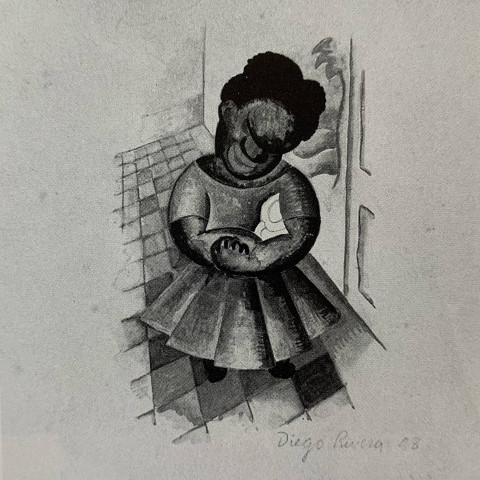Diego Rivera was born on December 13, 1886 in the mountain town of Guanajuato in Mexico. His mother was an ardent Catholic and his father was a rich and aristocratic revolutionary fighter and an atheist. Little Diego decided in favor of atheism. He swore his family had to leave Guanajuato when he was six because of his diatribes against the Church. When he was eleven he attended the San Carlos Academy of Fine Arts; his real teacher was Jose Posada, whose printmaking shop stood near the school.
At the age of twenty he won a traveling scholarship and spent the next three years in museums and painting in Europe, expressing little of what he felt. In 1910 he returned to Mexico and became involved in the revolution that ended with the forcing out of office the aging dictator Diaz. In 1911 his scholarship was renewed and he sailed for Europe again, this time for a period of ten years. In Paris, he set up housekeeping with a pretty Russian blonde named Angeline Beloff, his first common-law wife; from her he learned the Russian language and from her friends he learned all about Marxism. He also learned about Cubism and Picasso.
A trip to Italy gave him a chance to study Giotto, Uccello and Andrea del Castagno. In 1922 he returned again to Mexico and joined forces with two other revolutionaries, Siqueiros and Orozco. They formed a government-backed syndicate of artists who changed from easel painting to working on murals. In the next decade he did what was probably his greatest work: frescoes in Cuernavaca and in Chapingo, where his favorite model was Guadalupe Marin, a tempestuous olive-skinned beauty. They married and she bore him two daughters. He proved to be a master of figure composition, of space and light, of crowds of farm workers and battle scenes, etc.
In 1927 Rivera decided it was time for a visit of homage to Moscow; he met and sketched Stalin for which he was very honored. Later he did a complete reversal about Stalin. When he got home from Moscow he met and married a pretty art student named Frida Kahlo. They moved into her home in Coyoacan, a Mexico City suburb. Among their many guests was Leon Trotsky who lived with them for two years while he wrote a biography of Stalin, his enemy. Kahlo died in 1954 and not long after, Rivera married again; this time he married Emma Hurtado, a magazine publisher who also had a gallery dealing in Rivera paintings.
Rivera was notorious for his murals in which he openly expressed his opinions on many controversial subjects of the day. The most notorious of these was the one in Rockefeller Center which was reduced to dust by the Rockefeller family after Rivera refused to remove the painting of Lenin uniting the workers. Rivera also worked hard at painting society portraits by the dozen; he did very popular flower paintings, sexy nudes and typical Mexican scenes. He painted the beautiful Dolores Del Rio and Paulette Goddard, the movie actress who posed for him at least twelve times. He made a lot of money which he got rid of as fast as he could make it. He was known as the softest touch in all of Mexico, giving away money to friends, guests and street beggars. He died in Mexico City on November 24, 1957.
Source: askart.com

